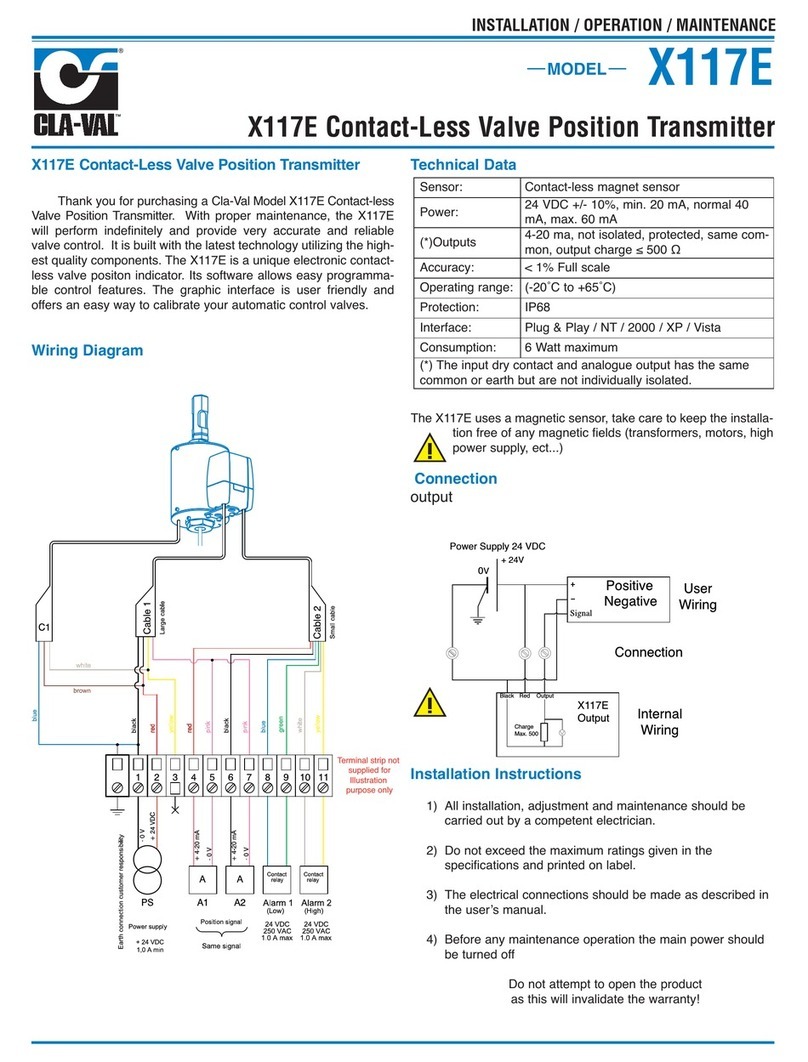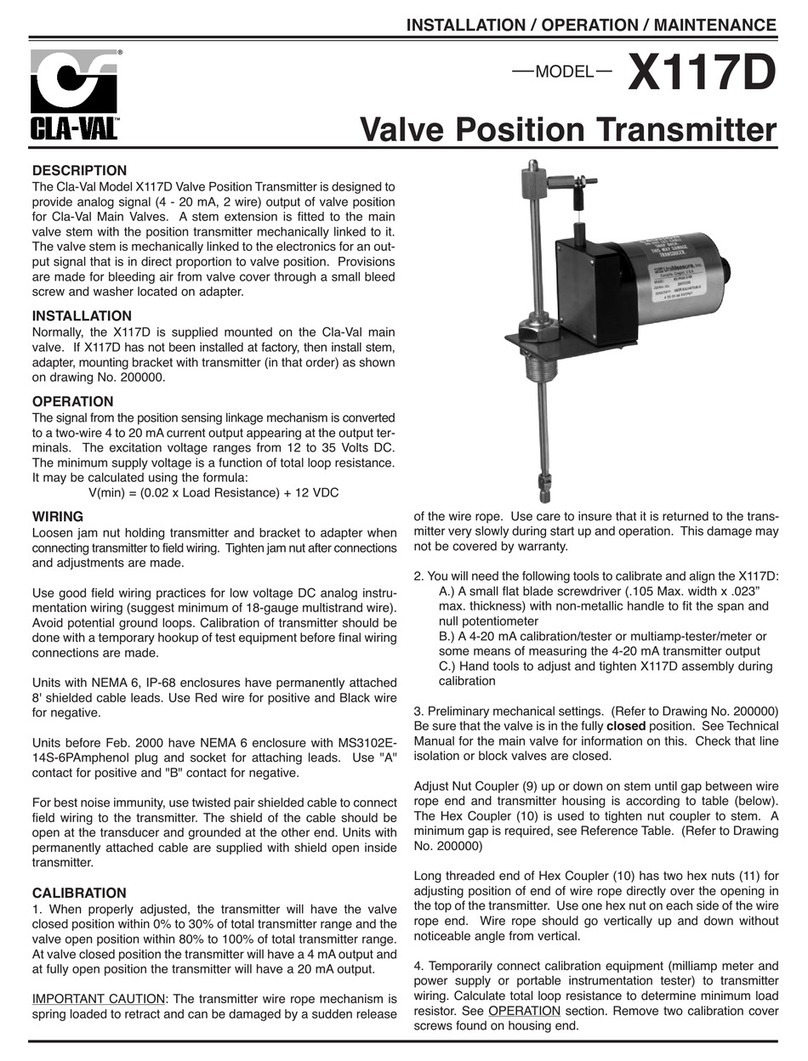
WIRING
Loosen jam nut holding transmitter and bracket to adapter when
connecting transmitter to field wiring. Tighten jam nut after connections
and adjustments are made.
Use good field wiring practices for low voltage DC analog instru-
mentation wiring (suggest minimum of 18-gauge multistrand wire).
Avoid potential ground loops. Calibration of transmitter should be
done with a temporary hookup of test equipment before final wiring
connections are made.
Units with NEMA 6, IP-68 enclosures have permanently attached
8' shielded cable leads. Use Red wire for positive and Black wire
for negative.
Units before Feb. 2000 have NEMA 6 enclosure with MS3102E-
14S-6PAmphenol plug and socket for attaching leads. Use "A"
contact for positive and "B" contact for negative.
For best noise immunity, use twisted pair shielded cable to connect
field wiring to the transmitter. The shield of the cable should be
open at the transducer and grounded at the other end. Units with
permanently attached cable are supplied with shield open inside
transmitter.
CALIBRATION
1. When properly adjusted, the transmitter will have the valve
closed position within 0% to 30% of total transmitter range and the
valve open position within 80% to 100% of total transmitter range.
At valve closed position the transmitter will have a 4 mA output and
at fully open position the transmitter will have a 20 mA output.
IMPORTANT CAUTION: The transmitter wire rope mechanism is
spring loaded to retract and can be damaged by a sudden release
of the wire rope. Use care to insure that it is returned to the trans-
mitter very slowly during start up and operation. This damage may
not be covered by warranty.
2. You will need the following tools to calibrate and align the X117D:
A.) A small flat blade screwdriver (.105 Max. width x .023”
max. thickness) with non-metallic handle to fit the span and
null potentiometer
B.) A 4-20 mA calibration/tester or multiamp-tester/meter or
some means of measuring the 4-20 mA transmitter output
C.) Hand tools to adjust and tighten X117D assembly during
calibration
3. Preliminary mechanical settings. (Refer to Drawing No. 200000)
Be sure that the valve is in the fully closed position. See Technical
Manual for the main valve for information on this. Check that line
isolation or block valves are closed.
Adjust Nut Coupler (9) up or down on stem until gap between wire
rope end and transmitter housing is according to table (below).
The Hex Coupler (10) is used to tighten nut coupler to stem. A
minimum gap is required, see Reference Table. (Refer to Drawing
No. 200000)
Long threaded end of Hex Coupler (10) has two hex nuts (11) for
adjusting position of end of wire rope directly over the opening in
the top of the transmitter. Use one hex nut on each side of the wire
rope end. Wire rope should go vertically up and down without
noticeable angle from vertical.
4. Temporarily connect calibration equipment (milliamp meter and
power supply or portable instrumentation tester) to transmitter
wiring. Calculate total loop resistance to determine minimum load
resistor. See OPERATION section. Remove two calibration cover
screws found on housing end.
Valve Position Transmitter
X117D
DESCRIPTION
The Cla-Val Model X117D Valve Position Transmitter is designed to
provide analog signal (4 - 20 mA, 2 wire) output of valve position
for Cla-Val Main Valves. A stem extension is fitted to the main
valve stem with the position transmitter mechanically linked to it.
The valve stem is mechanically linked to the electronics for an out-
put signal that is in direct proportion to valve position. Provisions
are made for bleeding air from valve cover through a small bleed
screw and washer located on adapter.
INSTALLATION
Normally, the X117D is supplied mounted on the Cla-Val main
valve. If X117D has not been installed at factory, then install stem,
adapter, mounting bracket with transmitter (in that order) as shown
on drawing No. 200000.
MODEL
INSTALLATION / OPERATION / MAINTENANCE
OPERATION
The signal from the position sensing linkage mechanism is converted
to a two-wire 4 to 20 mA current output appearing at the output ter-
minals. The excitation voltage ranges from 12 to 35 Volts DC.
The minimum supply voltage is a function of total loop resistance.
It may be calculated using the formula:
V(min) = (0.02 x Load Resistance) + 12 VDC





















